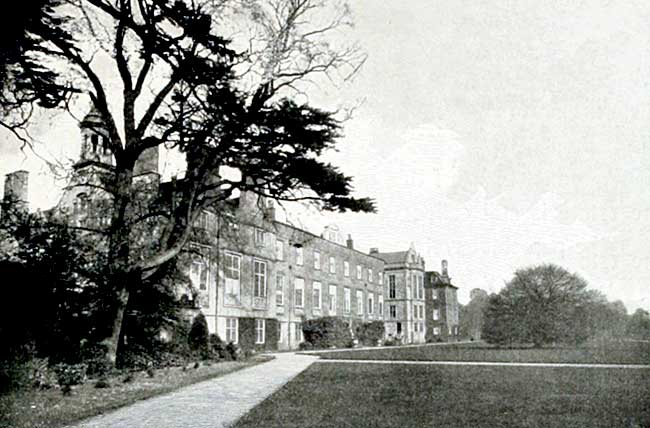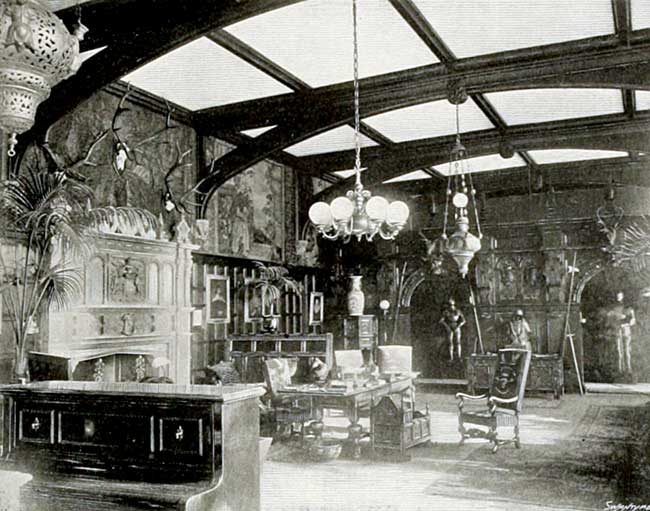Rufford Abbey
By J S Lumley-Savile

Rufford Abbey.
THE Manor of Rufford was at the commencement of the twelfth century the fee of Gilbert de Gaunt. This Gilbert was a grandson of Gislebert de Gaunt, a nephew of William the Conqueror, and his name appears on the roll of Battle Abbey. Gilbert married Roesia, Countess of Lincoln, and was himself created Earl of Lincoln. On his deathbed, in the year 1148, he bequeathed Rufford to a colony of Cistercian monks from Rievaulx. The deed of gift, which is in Latin, is in a perfect state of preservation. It bears the seal of Gilbert, and runs as follows: " I, Gilbert de Gaunt, Earle of Lincoln, to all men and to all his children of the Holy Church, greeting. Know ye me to have given and granted, in perpetual alms, to the monks of Rievaulx, for the souls of my father and mother, and for the remission of my sins, my manor of Rufford, and whatsoever I have there in domains, to make an abbey of the order of Cistercians, to the honour of our beloved Lady, Saint Mary the Virgin."
A confirmation of this gift was made by King Stephen, and the estate is still called the Liberty of Rufford, and is exempt from the parochial system.
When Henry VIII. swept away the abbeys of England, Rufford was given by him to George, fourth Earl of Shrewsbury. His grandson, the second Earl, had charge of Mary, Queen of Scots; he married firstly, a daughter of the first Earl of Rutland, by whom he had several children, and secondly, the celebrated Bess of Hardwick, widow of Sir W. Cavendish, by whom she had had three sons and three daughters. Her second daughter, Elizabeth, was married in the chapel at Rufford, to Charles Stuart, younger brother of Darnley, the father of James I., while he was on a visit there with his mother, the Countess of Lennox; the ill-fated Arabella Stuart was the result of this union. An amusing letter on the subject written by Lord Shrewsbury to Lord Burghley shows that he was very nervous as to the manner in which this act of his matchmaking and scheming wife would be viewed by his sovereign; his fears were not unfounded, for the mothers of both bride and bridegroom paid a short visit to the Tower. Meanwhile Bess had married her step-daughter, Lady Mary Talbot, to Sir George Savile of Thornhill, Lupset, and Wakefield, and the Rufford estate was made over to him. He was created a baronet June 29th, 1611.

The Brick Hall.
Their son, likewise Sir George, married Anne, daughter of Sir W. Wentworth, and sister of Thomas Wentworth, the great Earl of Stafford, of whom a splendid portrait by Van Dyck hangs in the billiard room.
Stafford was often the guest of his brother-in-law, Sir George. There are many interesting letters from him in the possession of the writer, among others one dated from Dublin Castle December 1633, addressed to his young nephew, to whom he gives, at considerable length, advice as to the management of his large estates; laying down many rules for his guidance through life generally, and warning him especially against making too early an appearance at Court, before he should be capable of contending with the dangers that would surely there beset him. In the Stafford papers he relates a curious anecdote of James I. when hunting with his court at Rufford. "The loss of the stag, and the hounds hunting foxes instead of deer, put the king into a marvellous chaff, accompanied with those ordinary symptoms better known to you couriers, I conceive, than to us rural swains: in the height whereof comes a clown galloping in and staring him full in the face: 'His blood!' quoth he, 'am I come forty miles to see a fellow?' And presently, in a great rage, turns about his horse, and away he goes faster than he came; the address whereof caused His Majesty and the company to burst out into a vehement laughter; and so the fume for that time was happily dispersed."
